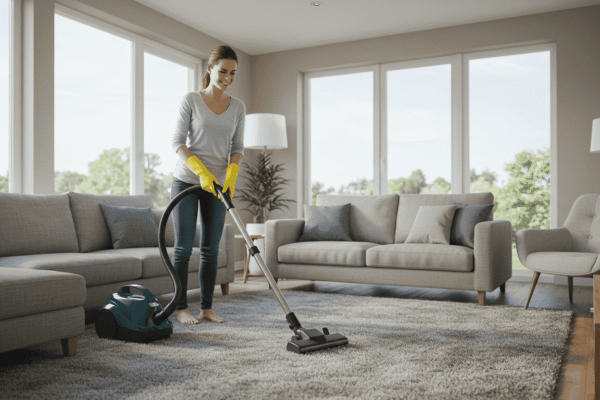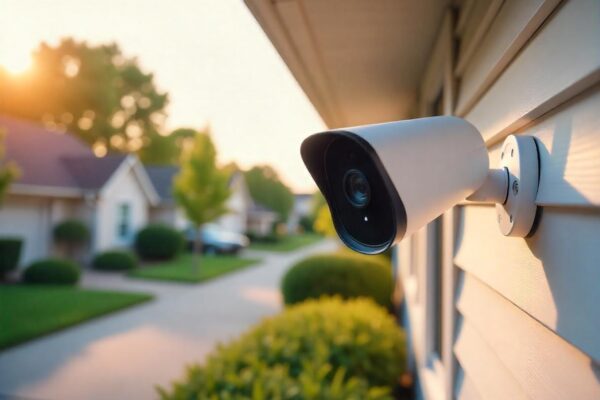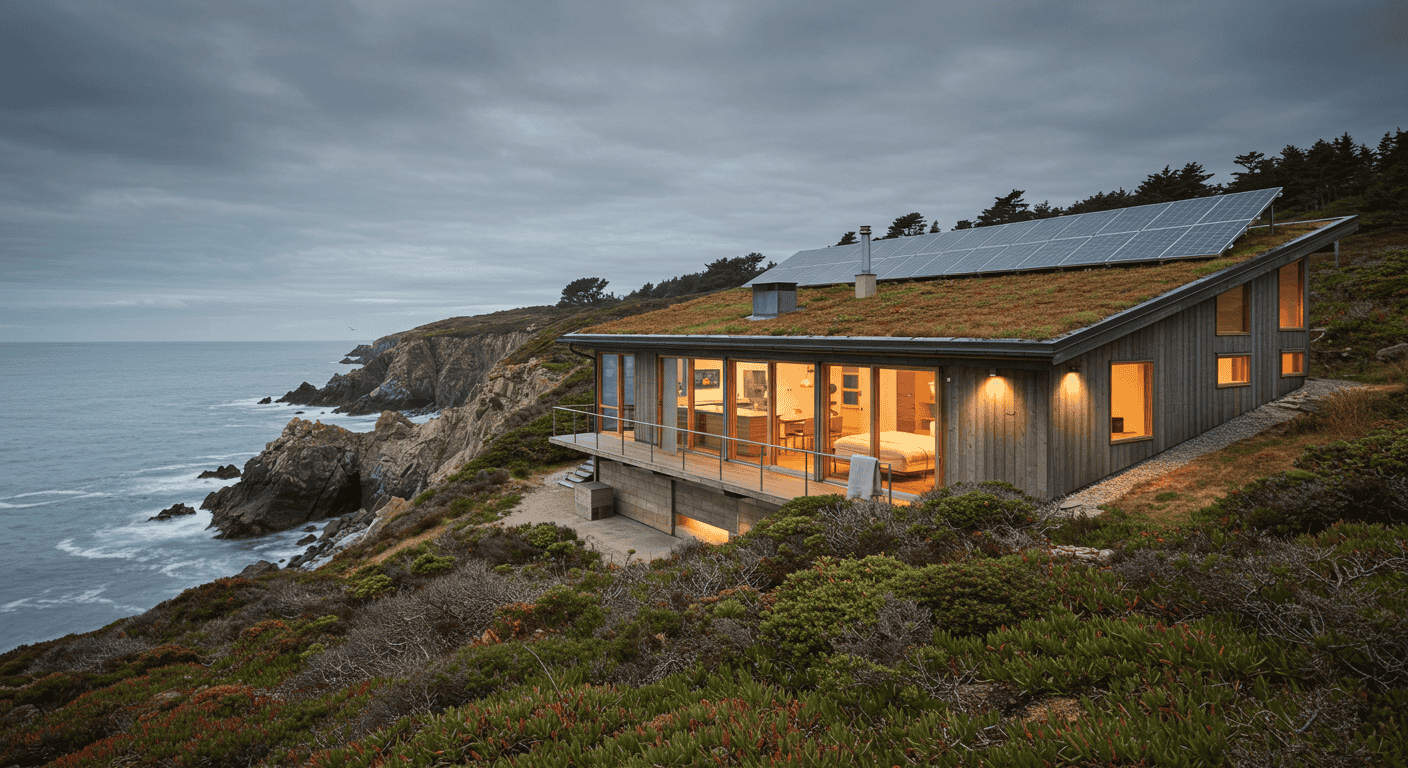Off-grid homes are becoming increasingly popular as people seek more sustainable off-grid living options and ways to save money on energy bills. By using alternative energy setups like solar, wind, hydro, or geothermal systems, homeowners can gain energy independence while reducing their reliance on traditional utilities. Beyond the financial benefits, off-grid living offers a chance to live more eco-friendly, minimize your carbon footprint, and embrace a lifestyle that is both practical and fulfilling. In this guide, we’ll explore how different off-grid energy solutions work, how to plan your system efficiently, and strategies to maximize cost savings while enjoying a sustainable home.
Introduction – Why Off-Grid Living is Gaining Popularity
The concept of off-grid homes is rapidly attracting attention as more homeowners look for ways to embrace sustainable off-grid living while reducing dependence on traditional utility systems. Advances in alternative energy setups and affordable technology have made it increasingly feasible for people to live independently of the grid. Beyond financial considerations, the appeal of living off-grid lies in its potential to offer a lifestyle that is eco-conscious, self-reliant, and aligned with long-term environmental goals. Understanding why off-grid homes are growing in popularity helps homeowners make informed decisions about their energy choices and the design of their residences.
The Rise of Sustainable Off-Grid Homes
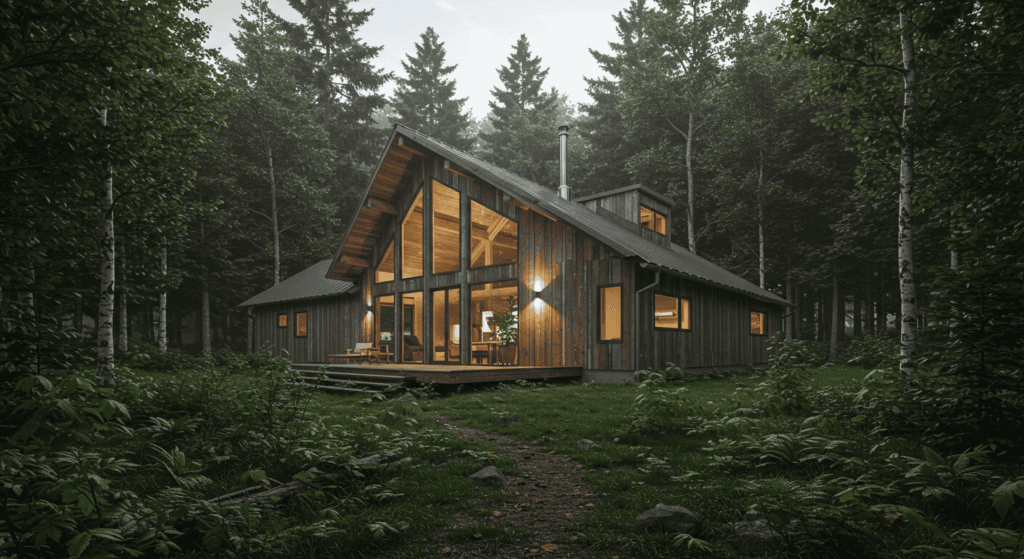
In recent years, the trend toward sustainable off-grid living has accelerated due to rising energy costs, climate concerns, and interest in self-sufficient lifestyles. Homeowners are turning to off-grid homes as a practical way to combine comfort with responsibility toward the environment. Modern designs now incorporate efficient layouts, energy-saving technologies, and alternative energy setups that make living off-grid more accessible than ever. This shift reflects a growing awareness of how renewable energy for homes can provide both independence and long-term savings.
How Alternative Energy Setups Can Reduce Costs
One of the primary drivers behind off-grid homes is the ability to lower ongoing energy expenses. By leveraging alternative energy setups such as solar panels, wind turbines, or small-scale hydro systems, homeowners can reduce or even eliminate utility bills. Combining energy production with smart energy management systems allows households to optimize usage, store excess energy, and minimize waste. Over time, these strategies result in significant cost savings while offering a more predictable and controlled approach to household energy consumption.
Benefits Beyond Money – Energy Independence & Eco Impact
Living in off-grid homes offers more than just financial advantages. The adoption of alternative energy setups promotes energy independence, giving homeowners control over how they produce, store, and consume energy. Additionally, reducing reliance on fossil fuels lowers the household’s carbon footprint and contributes to a more eco-friendly home energy solution. Off-grid living encourages sustainable practices, from water conservation to efficient energy use, allowing residents to lead a lifestyle that aligns with environmental responsibility while enjoying the freedom of self-sufficiency.
Understanding Alternative Energy Setups for Homes
For homeowners exploring off-grid homes, understanding the different types of alternative energy setups is essential. Each energy source comes with its own benefits, limitations, and costs, making it important to select the right combination for your home’s location, size, and energy needs. By carefully evaluating these options, homeowners can achieve sustainable off-grid living that balances efficiency, reliability, and cost savings.
What Counts as Alternative Energy? (solar, wind, hydro, geothermal)
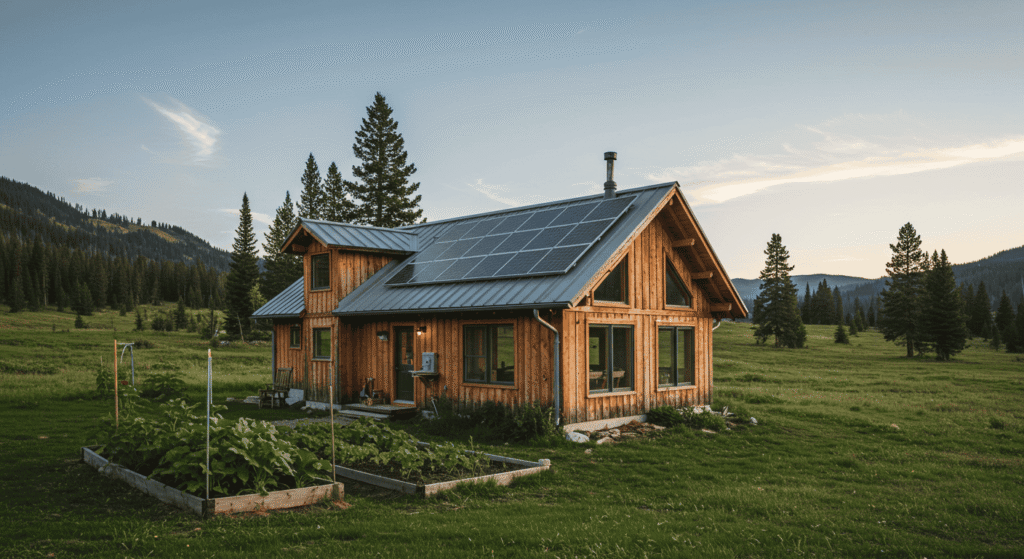
Alternative energy setups refer to any system that generates power independently of traditional grid electricity, relying instead on renewable sources. The most common types include:
- Solar energy: Converts sunlight into electricity using photovoltaic panels. Ideal for areas with high sun exposure.
- Wind energy: Uses turbines to generate electricity from wind flow. Best suited for open, windy locations.
- Hydro energy: Generates power from flowing water, often near rivers or streams. Provides a consistent energy supply in suitable locations.
- Geothermal energy: Harnesses heat from the Earth to produce electricity or heat homes. Works best in regions with accessible geothermal activity or cold climates where stable heat sources are beneficial.
Each energy type contributes differently to energy independence and can be adapted based on the homeowner’s priorities, whether it’s maximizing output, minimizing costs, or reducing maintenance requirements.
How These Setups Integrate Into Off-Grid Homes
Integrating alternative energy setups into an off-grid home requires careful planning and design. Most systems include energy generation units (solar panels, wind turbines, hydro turbines, or geothermal pumps), energy storage solutions (batteries), and management systems to monitor production and consumption. Proper integration ensures that energy is used efficiently, excess energy is stored for cloudy or low-wind days, and overall household energy needs are met reliably. Homeowners often combine multiple energy sources to achieve a hybrid system, enhancing sustainable off-grid living and increasing overall energy reliability.
Quick Comparison Table – Energy Types vs Suitability
The table below provides a clear overview of the main alternative energy setups for off-grid homes, including their best applications, setup costs, maintenance needs, and energy output potential:
| Energy Type | Best For | Initial Setup Cost | Maintenance Level | Energy Output Potential |
|---|---|---|---|---|
| Solar | Sunny areas | Medium | Low | High |
| Wind | Open spaces | Medium-High | Medium | Medium |
| Hydro | Near rivers | High | Low-Medium | High |
| Geothermal | Cold climates | High | Low | Medium-High |
This comparison helps homeowners choose the most suitable energy type or combination for their off-grid energy solutions, optimizing both efficiency and cost savings.
Planning Your Off-Grid Energy System
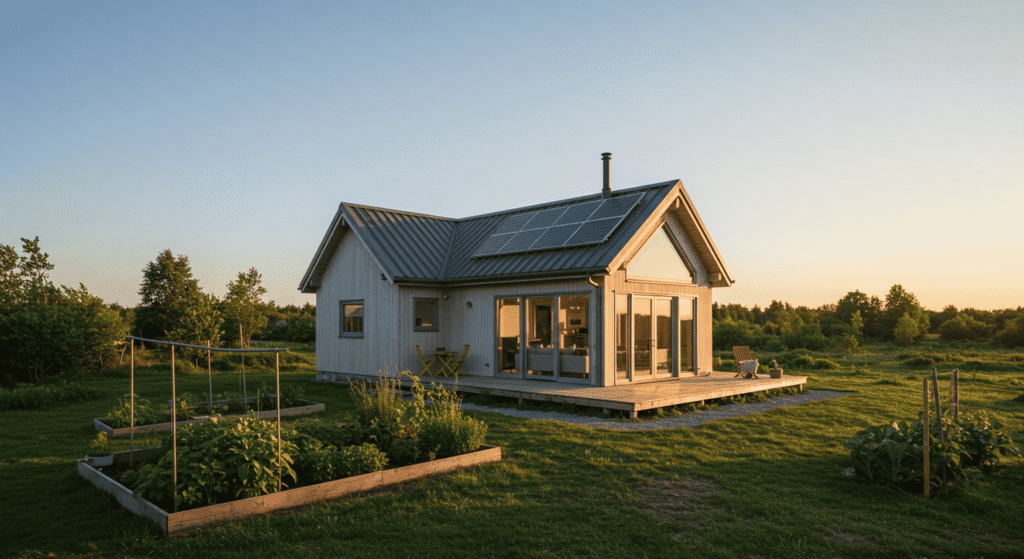
Designing an effective off-grid energy system is crucial for homeowners seeking sustainable off-grid living and cost savings. Proper planning ensures that your alternative energy setups meet your household’s energy demands while maintaining efficiency and reliability. This section explores how to assess energy needs and select the right combination of energy sources for your home.
Assessing Energy Needs for Your Home
Before choosing an alternative energy setup, it is essential to evaluate your home’s daily energy consumption. Consider all appliances, lighting, heating, cooling, and electronics that will rely on your system. Calculating energy needs helps determine the size of solar panels, wind turbines, batteries, or other systems required to maintain a stable energy supply. Understanding your household’s energy usage also allows you to implement energy-saving practices and select energy-efficient appliances, which reduce the overall demand and maximize cost savings.
Choosing the Right Combination of Energy Sources
No single energy source fits every off-grid home, so combining multiple alternative energy setups often provides the best balance of reliability and efficiency. For example, solar panels may work well in sunny regions, but adding a small wind turbine or hydro system can ensure power during cloudy days or seasonal variations. Selecting the right combination depends on local climate, space availability, budget, and your desired level of energy independence. Hybrid systems allow homeowners to maintain consistent energy production while minimizing interruptions and maximizing the potential for sustainable off-grid living.
Table – Typical Energy Consumption vs Setup Size
The table below illustrates typical energy needs for different home sizes and the corresponding off-grid energy setups recommended for optimal performance:
| Home Size | Daily Energy Need (kWh) | Recommended Energy Setup | Notes |
|---|---|---|---|
| Tiny Home | 10–15 | Small solar + battery | Minimal appliances |
| Small House | 25–40 | Solar + wind | Moderate appliances |
| Family Home | 50–80 | Solar + wind + hydro | Full energy independence |
This table helps homeowners quickly match their energy consumption to an appropriate setup, ensuring that the off-grid energy system is both efficient and cost-effective.
Cost-Saving Strategies for Off-Grid Homes
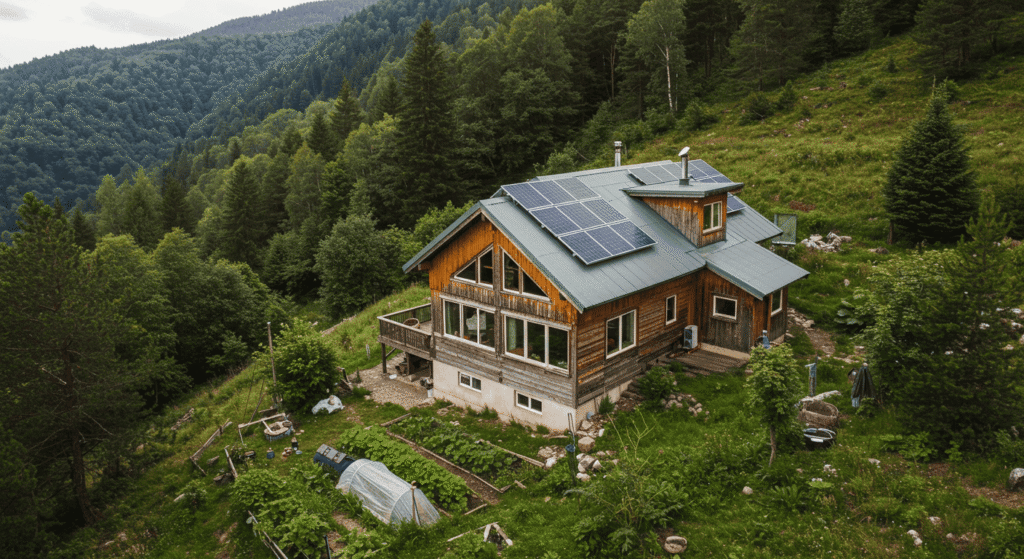
Creating off-grid homes that are both efficient and cost-effective requires careful planning and the implementation of practical strategies. By focusing on energy independence and smart management of alternative energy setups, homeowners can significantly reduce utility expenses while enjoying reliable and sustainable living. This section highlights key methods to save money and optimize your off-grid energy solutions.
Reducing Utility Bills through Energy Independence
One of the most significant advantages of off-grid homes is the potential to reduce or eliminate traditional utility bills. By relying on alternative energy setups such as solar panels, wind turbines, or hydro systems, households gain greater control over energy production and consumption. This energy independence not only provides long-term cost savings but also shields homeowners from fluctuating utility rates and potential power outages, making sustainable off-grid living more predictable and financially beneficial.
Efficient Energy Storage & Management
Efficient storage and management of energy are critical for maximizing cost savings in off-grid homes. Batteries store excess energy produced during peak production times, ensuring a consistent supply even during periods of low sunlight or wind. Pairing storage solutions with smart energy management systems allows homeowners to track consumption, prioritize critical loads, and optimize the use of available power. Effective management reduces energy waste and extends the lifespan of the system, further enhancing the benefits of alternative energy setups.
DIY vs Professional Setup – When Each Makes Sense
Deciding between a DIY or professionally installed system depends on your technical skills, budget, and long-term goals. DIY installations can lower upfront costs and provide hands-on experience with off-grid energy solutions, but they require careful research and ongoing maintenance. Professional setups often come with warranties, expert guidance, and optimized system design, making them ideal for larger or more complex off-grid homes. Balancing cost, reliability, and convenience helps homeowners select the most suitable approach.
Table – Cost-Saving Strategies for Off-Grid Homes
| Strategy | Cost Saving Potential | Pros | Cons |
|---|---|---|---|
| Solar Panels | High | Clean energy | High initial cost |
| Energy-Efficient Appliances | Medium | Lowers consumption | May require upgrades |
| Smart Energy Management | Medium | Optimizes usage | Requires monitoring |
This table offers a quick reference for homeowners to compare cost-saving strategies, helping them make informed decisions for maximizing sustainable off-grid living while keeping expenses under control.
Innovative Off-Grid Energy Solutions You Can Try
For homeowners looking to maximize off-grid energy solutions, combining innovative approaches can enhance both efficiency and reliability. By exploring hybrid systems and advanced storage methods, off-grid homes can maintain consistent energy production, reduce dependency on a single source, and achieve greater sustainable off-grid living with long-term cost savings.
Combining Multiple Renewable Sources
One of the most effective ways to optimize alternative energy setups is by combining multiple renewable sources. For instance, pairing solar panels with a small wind turbine ensures that energy is generated even when sunlight is limited, while adding a hydro or geothermal component can provide a steady baseline energy supply. Hybrid systems allow homeowners to tailor energy production to their location, climate, and household needs, providing redundancy and enhancing energy independence.
Energy Storage Innovations for Homeowners
Advanced energy storage is a key component of modern off-grid homes. Efficient storage solutions, such as high-capacity batteries and intelligent energy management systems, allow homeowners to store excess energy during peak production times and deploy it when needed. These innovations help maintain a reliable energy supply, minimize waste, and optimize the performance of alternative energy setups. Proper storage integration ensures that hybrid systems operate smoothly and consistently, even under varying environmental conditions.
Table – Hybrid Energy Setups & Their Benefits
| Hybrid Setup | Key Benefit | Ideal Home Type | Notes |
|---|---|---|---|
| Solar + Wind | Redundancy during bad weather | Rural homes | Seasonal optimization |
| Solar + Hydro | Constant energy supply | Near flowing water | Requires proximity to water source |
| Solar + Geothermal | Stable energy year-round | Cold climates | Long-term investment |
This table helps homeowners visualize the advantages of hybrid systems and select the most suitable combination for their off-grid energy setups, ensuring consistent energy production and reliable sustainable off-grid living.
Maintaining Your Alternative Energy Systems
Proper maintenance is essential for ensuring that off-grid homes operate efficiently and that alternative energy setups deliver reliable performance over time. Regular upkeep not only prolongs the lifespan of your systems but also maximizes energy independence and cost savings. In this section, we explore practical steps for maintaining your energy systems, troubleshooting issues, and tracking performance.
Routine Checks and Maintenance Tips
Routine maintenance is key to keeping alternative energy setups in optimal condition. Regular inspections of solar panels, wind turbines, hydro systems, and batteries help identify potential problems before they affect performance. Cleaning solar panels, tightening bolts on turbines, and monitoring battery health ensures that your off-grid energy solutions continue to function efficiently. Establishing a consistent maintenance schedule also helps homeowners plan for minor repairs, reducing the risk of costly downtime.
Troubleshooting Common Issues
Even with proper maintenance, off-grid homes can experience occasional issues such as reduced energy output, battery inefficiency, or mechanical wear. Troubleshooting involves identifying the root cause of the problem, whether it’s environmental factors, component failure, or connection issues. Understanding common problems and having a step-by-step approach ensures that homeowners can quickly restore their alternative energy setups to full operation, maintaining sustainable off-grid living without major interruptions.
Tracking Energy Production & Usage
Monitoring energy production and consumption is essential for optimizing off-grid energy systems. Keeping track of how much energy is generated, stored, and consumed allows homeowners to adjust usage patterns, identify inefficiencies, and plan for seasonal variations. By tracking performance, households can make informed decisions about expanding or upgrading their systems, ensuring consistent energy independence and long-term cost savings.
Table – Maintenance Tasks for Off-Grid Energy Systems
| Maintenance Task | Frequency | Tools Needed | Notes |
|---|---|---|---|
| Solar Panel Cleaning | Monthly | Soft cloth, water | Avoid harsh detergents |
| Wind Turbine Inspection | Quarterly | Wrench, safety harness | Check bolts and blades |
| Battery Check | Monthly | Multimeter | Monitor voltage & temperature |
This table provides a quick reference for homeowners to manage the routine upkeep of alternative energy setups, ensuring that their off-grid homes remain efficient, reliable, and cost-effective over the long term.
Common Challenges in Off-Grid Living & How to Overcome Them
While off-grid homes offer independence and cost savings, they also come with unique challenges that homeowners must anticipate. Understanding potential obstacles and implementing proactive solutions ensures that alternative energy setups continue to operate efficiently, supporting sustainable off-grid living even under varying conditions.
Seasonal Variations in Energy Production
One of the main challenges in off-grid homes is seasonal fluctuation in energy production. Solar panels may generate less electricity during cloudy winter months, and wind turbines can be less effective during periods of calm weather. To address these variations, homeowners can implement hybrid systems, use energy storage solutions like batteries, or adjust consumption habits to match periods of lower production. Planning for seasonal changes is essential to maintain energy independence and avoid unexpected energy shortfalls.
Managing Unexpected Energy Shortages
Unexpected energy shortages can occur due to equipment failure, unusually high energy demand, or environmental factors. Homeowners can mitigate these risks by incorporating energy-efficient appliances, maintaining a reserve battery supply, and monitoring daily energy usage. Preparing backup strategies and having redundancy built into alternative energy setups ensures that essential systems continue to operate even during unexpected shortfalls.
Table – Challenges vs Solutions
| Challenge | Possible Solution | Notes |
|---|---|---|
| Low sunlight | Backup battery or wind turbine | Seasonal planning helps |
| High energy demand | Energy-efficient appliances | Monitor usage |
| System failure | Regular maintenance & redundancy | Prepare a backup plan |
This table provides a clear overview of common obstacles faced by homeowners of off-grid homes and practical ways to address them. By anticipating challenges, residents can maintain reliable off-grid energy solutions while enjoying consistent sustainable off-grid living.
Realistic Savings and ROI of Off-Grid Homes
Investing in off-grid homes requires careful consideration of both upfront costs and long-term benefits. Understanding the potential return on investment (ROI) helps homeowners make informed decisions about alternative energy setups while maximizing cost savings and sustainable off-grid living.
Upfront Costs vs Long-Term Savings
The initial expense of installing alternative energy setups can vary depending on the size of the home and the complexity of the system. While upfront costs may seem significant, long-term savings on utility bills and reduced dependence on traditional energy sources often outweigh the initial investment. By evaluating projected energy consumption and system efficiency, homeowners can estimate how quickly their investment will pay off and identify strategies to optimize savings over time.
Energy Independence and Lifestyle Value
Beyond financial considerations, off-grid homes offer substantial lifestyle benefits. Achieving energy independence provides freedom from fluctuating utility rates, promotes self-sufficiency, and aligns with environmentally conscious living. The value of consistent, reliable energy and a smaller carbon footprint enhances overall quality of life, making sustainable off-grid living a compelling choice for homeowners seeking both economic and ecological benefits.
Table – Estimated ROI for Different Home Sizes
| Home Type | Setup Cost | Annual Savings | Estimated ROI (Years) | Notes |
|---|---|---|---|---|
| Tiny Home | Low | $800–$1,200 | 3–5 | Quick payoff |
| Small House | Medium | $2,500–$3,500 | 5–7 | Balanced investment |
| Family Home | High | $5,000–$7,000 | 8–12 | Long-term planning |
This table provides a practical reference for homeowners considering off-grid energy solutions, illustrating how system costs and potential cost savings vary by home size and helping guide decisions for both short-term affordability and long-term financial benefit.
Conclusion – Making Off-Grid Homes Work for You
Embracing off-grid homes is not just about saving money—it’s about creating a lifestyle rooted in sustainability, energy independence, and long-term resilience. With careful planning and the right alternative energy setups, any homeowner can reduce reliance on traditional utilities while enjoying the freedom of self-sufficient living.
Key Takeaways for Sustainable, Cost-Saving Living
Building an off-grid energy system requires balancing upfront investment with future rewards. By choosing efficient setups, integrating multiple renewable sources, and maintaining systems regularly, homeowners can ensure consistent energy production, lower expenses, and a reduced environmental footprint.
Encouragement for a Gradual Transition
Transitioning to an off-grid lifestyle doesn’t need to happen overnight. Start small—perhaps with solar panels or energy-efficient appliances—and gradually expand your system as needs and budget allow. Each step moves you closer to full independence and a home that works in harmony with nature.
Table – Quick Checklist for Starting Off-Grid Living
| Step | Action | Priority | Notes |
|---|---|---|---|
| 1 | Assess energy needs | High | Base calculations on appliances |
| 2 | Choose energy setup | High | Mix renewable sources |
| 3 | Plan storage & backup | Medium | Batteries, redundancy |
| 4 | Monitor usage | Medium | Track monthly energy consumption |
| 5 | Maintain system | High | Prevent costly downtime |
This checklist serves as a practical roadmap, ensuring that your journey toward sustainable off-grid living remains smooth, affordable, and rewarding.


